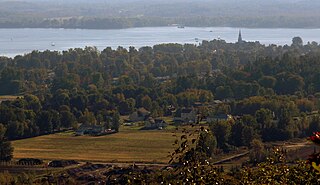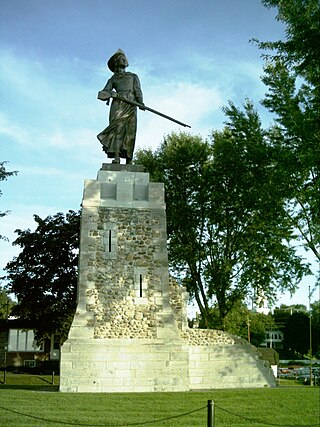
New France was the territory colonized by France in North America, beginning with the exploration of the Gulf of Saint Lawrence by Jacques Cartier in 1534 and ending with the cession of New France to Great Britain and Spain in 1763 under the Treaty of Paris.

The Beaver Wars, also known as the Iroquois Wars or the French and Iroquois Wars were a series of conflicts fought intermittently during the 17th century in North America throughout the Saint Lawrence River valley in Canada and the lower Great Lakes region which pitted the Iroquois against the Hurons, northern Algonquians and their French allies. As a result of this conflict, the Iroquois destroyed several confederacies and tribes through warfare: the Hurons or Wendat, Erie, Neutral, Wenro, Petun, Susquehannock, Mahican and northern Algonquins whom they defeated and dispersed, some fleeing to neighboring peoples and others assimilated, routed, or killed.

This section of the Timeline of Quebec history concerns the events between the foundation of Quebec and establishment of the Sovereign Council.

Events from the 1640s in Canada.

Events from the 1660s in Canada.

Dollard-des-Ormeaux is a predominantly English-speaking suburb of Montreal in southwestern Quebec, Canada. It is located on the Island of Montreal. The town was named after French martyr Adam Dollard des Ormeaux.

Oka is a small village on the northern bank of the Ottawa River, northwest of Montreal, Quebec, Canada. Located in the Laurentians valley on Lake of Two Mountains, where the Ottawa has its confluence with the St. Lawrence River, the town is connected via Quebec Route 344. It is located 50 km west of Montreal.

Adam Dollard des Ormeaux is an iconic figure in the history of New France. Arriving in the colony in 1658, Dollard was appointed the position of garrison commander of the fort of Ville-Marie. In the spring of 1660, Dollard led an expedition up the Ottawa River to wage war on the Iroquois. Accompanied by seventeen Frenchmen, Dollard arrived at the foot of Long Sault on May 1 and settled his troops at an abandoned Algonquin fort. He was then joined by forty Huron and four Algonquin allies. Vastly outnumbered by the Iroquois, Dollard and his companions died at the Battle of Long Sault somewhere between May 9 and May 12, 1660. The exact nature or purpose of Dollard's 1660 expedition is uncertain; however, most historians agree that Dollard set out to conduct a "petite guerre" (ambush) against the Iroquois, in order to delay their imminent attack on Ville-Marie. For these reasons, Dollard is regarded as one of the saviors of New France.

The Carignan-Salières Regiment was a Piedmont French military unit formed by merging two other regiments in 1659. They were led by the new Governor, Daniel de Rémy de Courcelles, and Lieutenant-General Alexandre de Prouville, Sieur de Tracy. Approximately 1,200 men arrived in New France in the middle of 1665.

The siege of Fort Detroit was an ultimately unsuccessful attempt by North American Indians to capture Fort Detroit during Pontiac's Rebellion. The siege was led primarily by Pontiac, an Ottawa chief and military leader. This rebellion would be one of the catalysts that hastened the declaration of the Proclamation of 1763 which would eventually precipitate the events leading to the American Revolution.

Marie-Madeleine Jarret, known as Madeleine de Verchères was a woman of New France credited with repelling a raid on Fort Verchères when she was 14 years old.
René Ménard was a French Jesuit missionary explorer who traveled to New France in 1641, learned the language of the Wyandot, and was soon in charge of many of the satellite missions around Sainte-Marie among the Hurons. Ménard also worked with the Iroquois, and was said to speak six Indian dialects. He survived the continuous attacks from the Iroquois on the Huron.
François-Marie Picoté, sieur de Belestre II was a colonial soldier for both New France and Great Britain.

The Lachine massacre, part of the Beaver Wars, occurred when 1,500 Mohawk warriors launched a surprise attack against the small settlement of Lachine, New France, at the upper end of Montreal Island, on the morning of August 5, 1689.

Saint-André-d'Argenteuil is a municipality in the Laurentides region of Quebec, Canada, part of the Argenteuil Regional County Municipality. It is located along the Ottawa River, just south of Lachute.

The Société Notre-Dame de Montréal, otherwise known as the Société de Notre-Dame de Montréal pour la conversion des Sauvages de la Nouvelle-France, was a religious organisation responsible for founding Ville-Marie, the original name for the settlement that would later become Montreal. The original founders of the organization were Jérôme le Royer de la Dauversière, Jean-Jacques Olier and Pierre Chevrier. They were later joined by Paul Chomedey de Maisonneuve and Jeanne Mance. The organization's mission was to convert the Indigenous population to Christianity and found a Christian settlement, which would be later known as Ville-Marie.

Fort Ville-Marie was a French fortress and settlement established in May 1642 by a company of French settlers, led by Paul de Chomedey de Maisonneuve, on the Island of Montreal in the Saint Lawrence River at the confluence of the Ottawa River, in what is today the province of Quebec, Canada. Its name is French for "City of Mary", a reference to the Blessed Virgin Mary.

Louis-Philippe Hébert (1850–1917) was a Canadian sculptor. He is considered one of the best sculptors of his generation.

Kondiaronk, known as Le Rat, was Chief of the Native American Wendat people at Michilimackinac in New France. As a result of an Iroquois attack and dispersal of the Hurons in 1649, the latter settled in Michilimackinac. The Michilimackinac area refers to the strait between Lakes Huron and Michigan in the present day United States.
Pieskaret was a famous chief of the Adirondac Indians. His tribe fought against the English forces, helping the French in the early 17th century. The Adirondacs under him drove the Iroquois Confederation out of Canada.

















